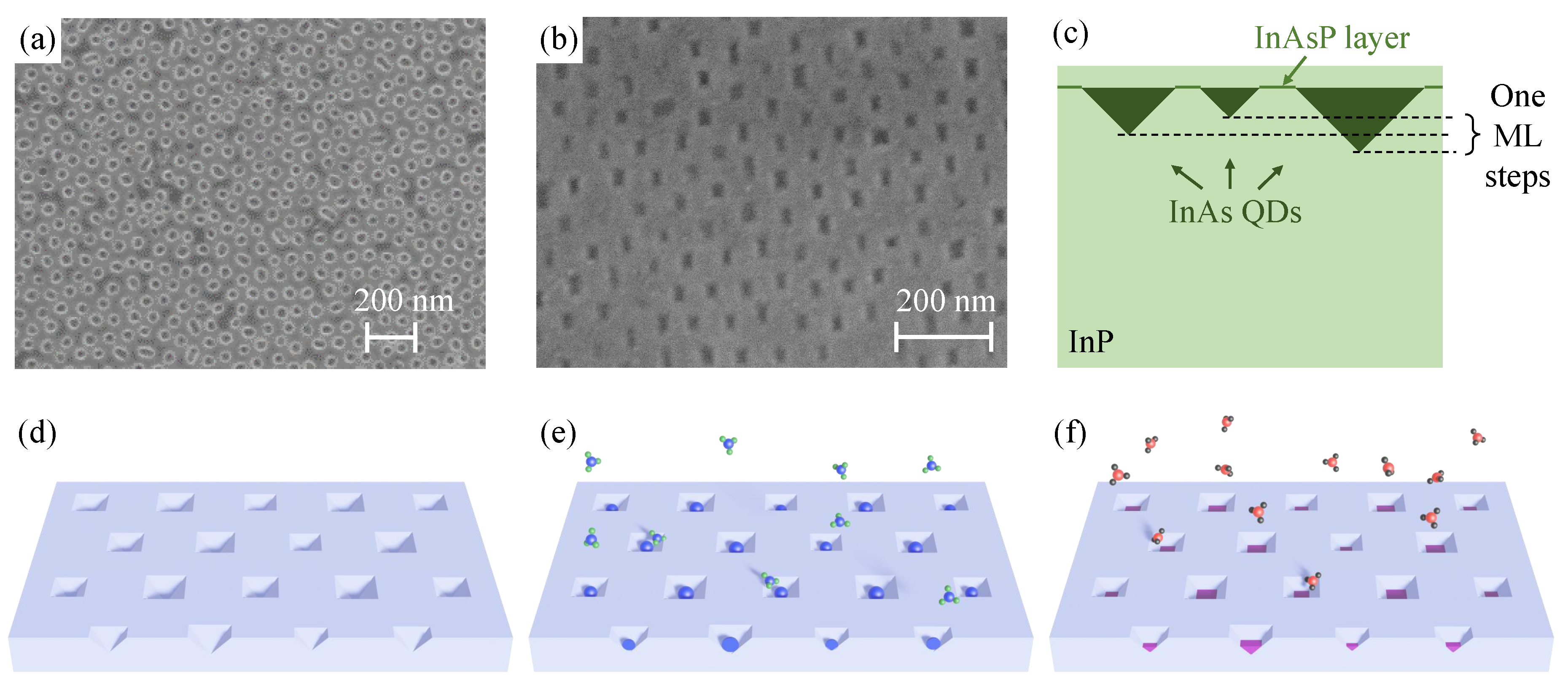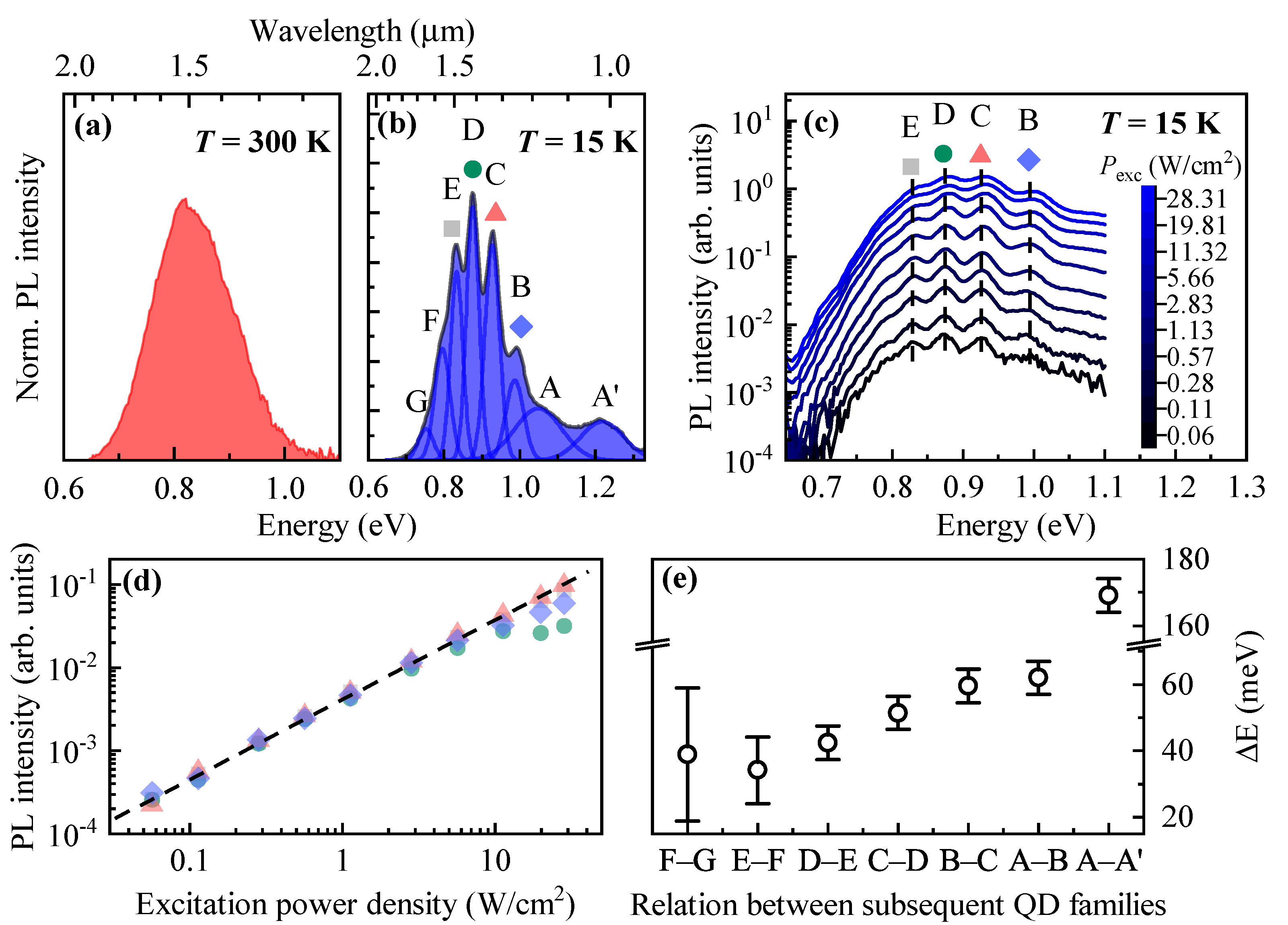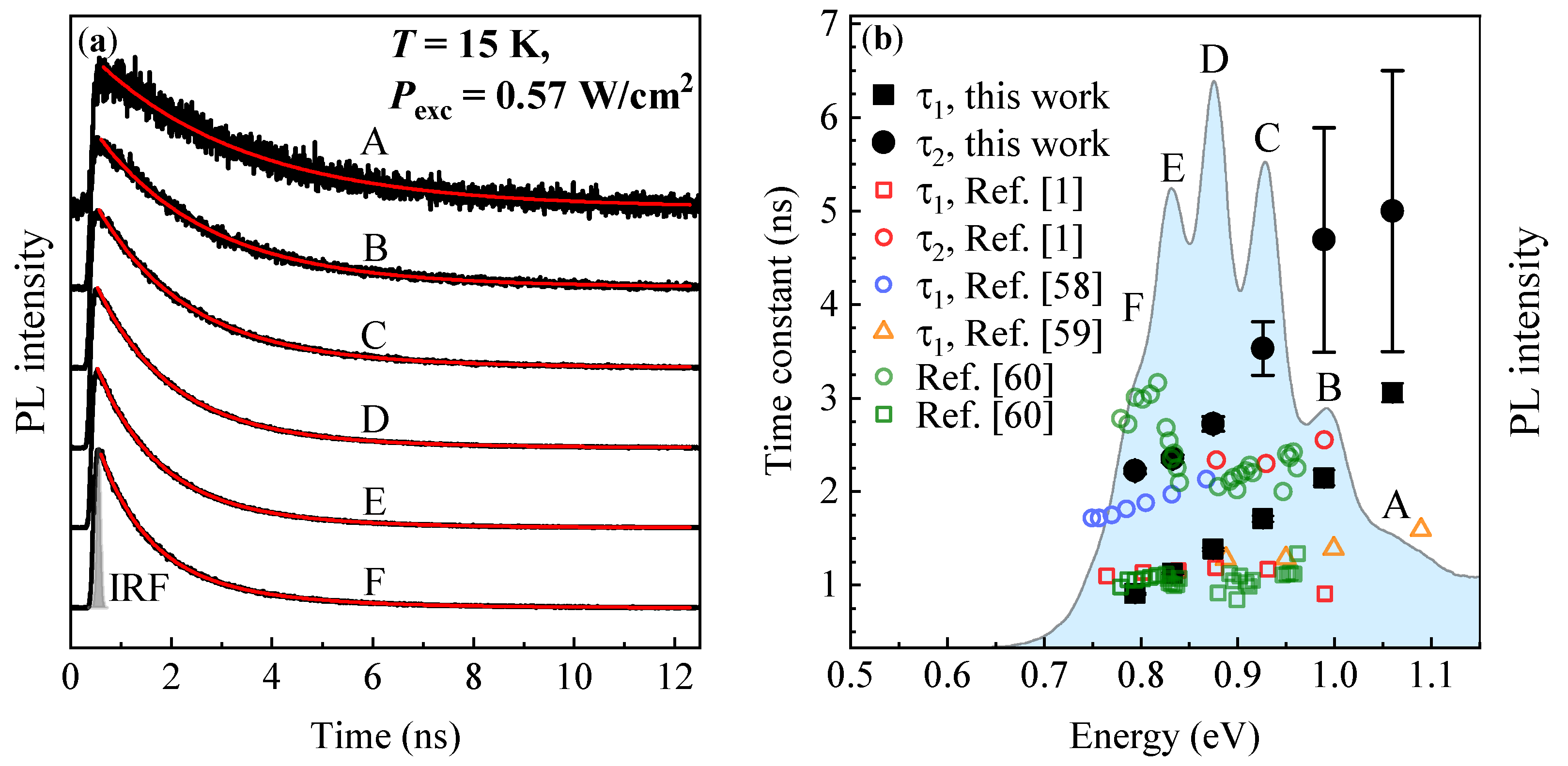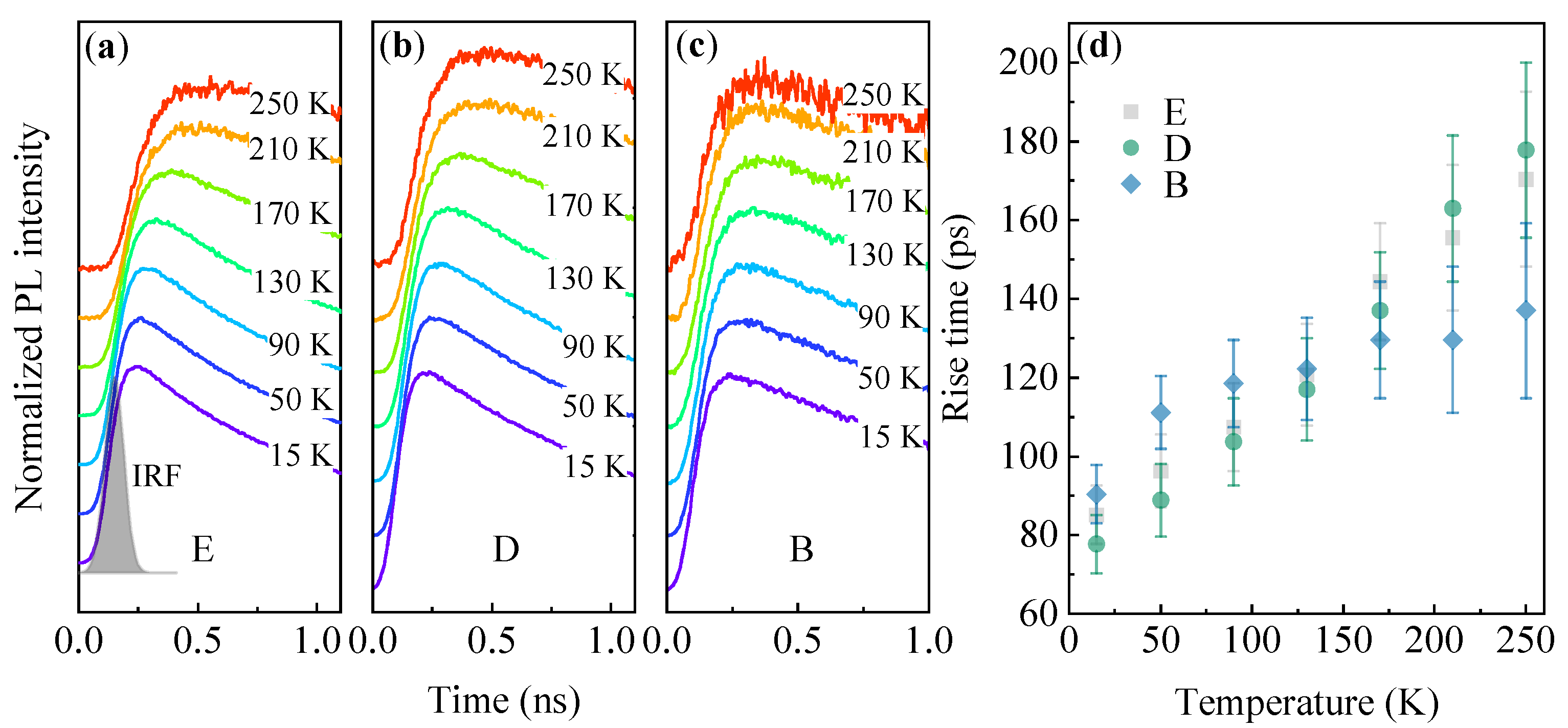Optical Properties of Site-Selectively Grown InAs/InP Quantum Dots with Predefined Positioning by Block Copolymer Lithography
Abstract
1. Introduction
2. Results and Discussion
2.1. Investigated Structure
2.2. Excitation-Power-Dependent PL Experiment
2.3. Temperature-Dependent PL Experiment
2.4. Time-Resolved PL Experiment
2.5. Calculations of the QD Electronic Structure
3. Experimental and Theoretical Methods
3.1. Fabrication of Nanopits
3.2. Droplet Epitaxy of QDs
3.3. Optical Methods
3.4. Calculations of the QD Band Structure
4. Conclusions
Author Contributions
Funding
Institutional Review Board Statement
Informed Consent Statement
Data Availability Statement
Conflicts of Interest
Abbreviations
| DE | Droplet epitaxy |
| e-h | Electron-hole |
| FWHM | Full-Width-at-Half-Maximum |
| ICP-RIE | Inductively coupled plasma-reactive ion etching |
| MOVPE | Metalorganic vapor-phase epitaxy |
| PL | Photoluminescence |
| PS-b-PDMS | Polystyrene-block-polydimethylsiloxane |
| QDs | Quantum dots |
| QW | Quantum well |
| SAG | Selective-area growth |
| SEM | Scanning electron microscope |
| SK | Stranski–Krastanov |
| TBP | Tertiarybutylphosphine |
| TRPL | Time-resolved photoluminescence |
| TMIn | Trimethylindium |
| WL | Wetting layer |
References
- Holewa, P.; Gawełczyk, M.; Ciostek, C.; Wyborski, P.; Kadkhodazadeh, S.; Semenova, E.; Syperek, M. Optical and electronic properties of low-density InAs/InP quantum-dot-like structures designed for single-photon emitters at telecom wavelengths. Phys. Rev. B 2020, 101, 195304. [Google Scholar] [CrossRef]
- Holewa, P.; Gawełczyk, M.; Maryński, A.; Wyborski, P.; Reithmaier, J.; Sęk, G.; Benyoucef, M.; Syperek, M. Optical and Electronic Properties of Symmetric InAs/(In,Al,Ga)As/InP Quantum Dots Formed by Ripening in Molecular Beam Epitaxy: A Potential System for Broad-Range Single-Photon Telecom Emitters. Phys. Rev. Appl. 2020, 14, 064054. [Google Scholar] [CrossRef]
- Dusanowski, Ł.; Mrowiński, P.; Syperek, M.; Misiewicz, J.; Somers, A.; Höfling, S.; Reithmaier, J.P.; Sęk, G. Confinement regime in self-assembled InAs/InAlGaAs/InP quantum dashes determined from exciton and biexciton recombination kinetics. Appl. Phys. Lett. 2017, 111, 253106. [Google Scholar] [CrossRef]
- Wang, R.; Stintz, A.; Varangis, P.; Newell, T.; Li, H.; Malloy, K.; Lester, L. Room-temperature operation of InAs quantum-dash lasers on InP [001]. IEEE Photonics Technol. Lett. 2001, 13, 767–769. [Google Scholar] [CrossRef]
- Akiyama, T.; Sugawara, M.; Arakawa, Y. Quantum-Dot Semiconductor Optical Amplifiers. Proc. IEEE 2007, 95, 1757–1766. [Google Scholar] [CrossRef]
- Reithmaier, J.; Eisenstein, G.; Forchel, A. InAs/InP Quantum-Dash Lasers and Amplifiers. Proc. IEEE 2007, 95, 1779–1790. [Google Scholar] [CrossRef]
- Khan, M.Z.M.; Ng, T.K.; Ooi, B.S. Self-assembled InAs/InP quantum dots and quantum dashes: Material structures and devices. Prog. Quantum Electron. 2014, 38, 237–313. [Google Scholar] [CrossRef]
- Semenova, E.S.; Kulkova, I.V.; Kadkhodazadeh, S.; Schubert, M.; Yvind, K. Metal organic vapor-phase epitaxy of InAs/InGaAsP quantum dots for laser applications at 1.5 μm. Appl. Phys. Lett. 2011, 99, 101106. [Google Scholar] [CrossRef]
- Yu, Y.; Xue, W.; Semenova, E.; Yvind, K.; Mørk, J. Demonstration of a self-pulsing photonic crystal Fano laser. Nat. Photonics 2016, 11, 81–84. [Google Scholar] [CrossRef]
- Xue, W.; Yu, Y.; Ottaviano, L.; Chen, Y.; Semenova, E.; Yvind, K.; Mørk, J. Threshold Characteristics of Slow-Light Photonic Crystal Lasers. Phys. Rev. Lett. 2016, 116, 063901. [Google Scholar] [CrossRef] [PubMed]
- Arakawa, Y.; Sakaki, H. Multidimensional quantum well laser and temperature dependence of its threshold current. Appl. Phys. Lett. 1982, 40, 939–941. [Google Scholar] [CrossRef]
- Berg, T.W.; Mørk, J. Quantum dot amplifiers with high output power and low noise. Appl. Phys. Lett. 2003, 82, 3083–3085. [Google Scholar] [CrossRef]
- Semenova, E.S.; Kulkova, I.V.; Kadkhodazadeh, S.; Barettin, D.; Kopylov, O.; Cagliani, A.; Almdal, K.; Willatzen, M.; Yvind, K. Epitaxial growth of quantum dots on InP for device applications operating at the 1.55 μm wavelength range. In Quantum Dots and Nanostructures: Synthesis, Characterization, and Modeling XI; Huffaker, D.L., Szmulowicz, F., Eisele, H., Eds.; SPIE: Bellingham, WA, USA, 2014. [Google Scholar] [CrossRef]
- Syperek, M.; Baranowski, M.; Sęk, G.; Misiewicz, J.; Löffler, A.; Höfling, S.; Reitzenstein, S.; Kamp, M.; Forchel, A. Impact of wetting-layer density of states on the carrier relaxation process in low indium content self-assembled (In,Ga)As/GaAs quantum dots. Phys. Rev. B 2013, 87, 125305. [Google Scholar] [CrossRef]
- Matthews, D.R.; Summers, H.D.; Smowton, P.M.; Hopkinson, M. Experimental investigation of the effect of wetting-layer states on the gain–current characteristic of quantum-dot lasers. Appl. Phys. Lett. 2002, 81, 4904–4906. [Google Scholar] [CrossRef]
- Liu, G.; Stintz, A.; Li, H.; Newell, T.; Gray, A.; Varangis, P.; Malloy, K.; Lester, L. The influence of quantum-well composition on the performance of quantum dot lasers using InAs-InGaAs dots-in-a-well (DWELL) structures. IEEE J. Quantum Electron. 2000, 36, 1272–1279. [Google Scholar] [CrossRef]
- Zhukov, A.E.; Kovsh, A.R.; Ustinov, V.M.; Egorov, A.Y.; Ledentsov, N.N.; Tsatsulnikov, A.F.; Maximov, M.V.; Shernyakov, Y.M.; Kopchatov, V.I.; Lunev, A.V.; et al. Gain characteristics of quantum dot injection lasers. Semicond. Sci. Technol. 1999, 14, 118–123. [Google Scholar] [CrossRef]
- Wilk, A.; Kovsh, A.; Mikhrin, S.; Chaix, C.; Novikov, I.; Maximov, M.; Shernyakov, Y.; Ustinov, V.; Ledentsov, N. High-power InAs/GaInAs/GaAs QD lasers grown in a multiwafer MBE production system. J. Cryst. Growth 2005, 278, 335–341. [Google Scholar] [CrossRef]
- Bhattacharya, P.; Singh, J.; Yoon, H.; Zhang, X.; Gutierrez-Aitken, A.; Lam, Y. Tunneling injection lasers: A new class of lasers with reduced hot carrier effects. IEEE J. Quantum Electron. 1996, 32, 1620–1629. [Google Scholar] [CrossRef]
- Nemcsics, A. Quantum Dots Prepared by Droplet Epitaxial Method. In Quantum Dots—Theory and Applications; InTech: London, UK, 2015. [Google Scholar] [CrossRef]
- Chikyow, T.; Koguchi, N. MBE Growth Method for Pyramid-Shaped GaAs Micro Crystals on ZnSe(001) Surface Using Ga Droplets. Jpn. J. Appl. Phys. 1990, 29, L2093–L2095. [Google Scholar] [CrossRef]
- Gurioli, M.; Wang, Z.; Rastelli, A.; Kuroda, T.; Sanguinetti, S. Droplet epitaxy of semiconductor nanostructures for quantum photonic devices. Nat. Mater. 2019, 18, 799–810. [Google Scholar] [CrossRef] [PubMed]
- Song, H.Z.; Usuki, T.; Hirose, S.; Takemoto, K.; Nakata, Y.; Yokoyama, N.; Sakuma, Y. Site-controlled photoluminescence at telecommunication wavelength from InAs/InP quantum dots. Appl. Phys. Lett. 2005, 86, 113118. [Google Scholar] [CrossRef]
- Turala, A.; Regreny, P.; Rojo-Romeo, P.; Priester, C.; Gendry, M. Localized growth of InAs quantum dots (QDs) on nanopatterned InP(001) surfaces. In Proceedings of the 2006 International Conference on Indium Phosphide and Related Materials Conference Proceedings, Princeton, NJ, USA, 7–11 May 2006; pp. 214–217. [Google Scholar] [CrossRef]
- Kuech, T.F.; Mawst, L.J. Nanofabrication of III–V semiconductors employing diblock copolymer lithography. J. Phys. D Appl. Phys. 2010, 43, 183001. [Google Scholar] [CrossRef]
- Park, J.H.; Liu, C.C.; Rathi, M.K.; Mawst, L.J.; Nealey, P.F.; Kuech, T.F. Nanoscale selective growth and optical characteristics of quantum dots on III–V substrates prepared by diblock copolymer nanopatterning. J. Nanophotonics 2009, 3, 1–12. [Google Scholar] [CrossRef]
- Kim, J.H.; Cai, T.; Richardson, C.J.K.; Leavitt, R.P.; Waks, E. Two-photon interference from a bright single-photon source at telecom wavelengths. Optica 2016, 3, 577. [Google Scholar] [CrossRef]
- Kim, H.; Wei, W.; Kuech, T.F.; Gopalan, P.; Mawst, L.J. Quantum Dot Laser Diodes emitting 1.57~1.67 μm at room temperature grown by Block Copolymer Lithography and Selective Area MOCVD. In Proceedings of the 2018 IEEE International Semiconductor Laser Conference, Santa Fe, NM, USA, 16–19 September 2018; pp. 63–64. [Google Scholar] [CrossRef]
- Shikin, A.; Lebedkina, E.; Ciostek, C.; Holewa, P.; Ndoni, S.; Almdal, K.; Yvind, K.; Syperek, M.; Semenova, E. Synthesis and systematic optical investigation of selective area droplet epitaxy of InAs/InP quantum dots assisted by block copolymer lithography. Opt. Mater. Express 2019, 9, 1738. [Google Scholar] [CrossRef]
- Kim, H.; Choi, J.; Lingley, Z.; Brodie, M.; Sin, Y.; Kuech, T.F.; Gopalan, P.; Mawst, L.J. Selective growth of strained (In)GaAs quantum dots on GaAs substrates employing diblock copolymer lithography nanopatterning. J. Cryst. Growth 2017, 465, 48–54. [Google Scholar] [CrossRef]
- Hamley, I. Ordering in thin films of block copolymers: Fundamentals to potential applications. Prog. Polym. Sci. 2009, 34, 1161–1210. [Google Scholar] [CrossRef]
- Jung, Y.S.; Ross, C.A. Solvent-Vapor-Induced Tunability of Self-Assembled Block Copolymer Patterns. Adv. Mater. 2009, 21, 2540–2545. [Google Scholar] [CrossRef]
- Gotrik, K.W.; Hannon, A.F.; Son, J.G.; Keller, B.; Alexander-Katz, A.; Ross, C.A. Morphology Control in Block Copolymer Films Using Mixed Solvent Vapors. ACS Nano 2012, 6, 8052–8059. [Google Scholar] [CrossRef]
- Li, T.; Wang, Z.; Schulte, L.; Hansen, O.; Ndoni, S. Fast & scalable pattern transfer via block copolymer nanolithography. RSC Adv. 2015, 5, 102619–102624. [Google Scholar] [CrossRef]
- Kuznetsova, N.; Kulkova, I.; Semenova, E.; Kadhodazadeh, S.; Kryzhanovskaya, N.; Zhukov, A.; Yvind, K. Crystallographic dependent in-situ CBr4 selective nano-area etching and local regrowth of InP/InGaAs by MOVPE. J. Cryst. Growth 2014, 406, 111–115. [Google Scholar] [CrossRef]
- Gong, M.; Duan, K.; Li, C.F.; Magri, R.; Narvaez, G.A.; He, L. Electronic structure of self-assembled InAs/InP quantum dots: Comparison with self-assembled InAs/GaAs quantum dots. Phys. Rev. B 2008, 77, 045326. [Google Scholar] [CrossRef]
- Gustafsson, A.; Hessman, D.; Samuelson, L.; Carlin, J.; Houdré, R.; Rudra, A. Cathodoluminescence investigations of three-dimensional island formation in quantum wells. J. Cryst. Growth 1995, 147, 27–34. [Google Scholar] [CrossRef]
- Poole, P.J.; McCaffrey, J.; Williams, R.L.; Lefebvre, J.; Chithrani, D. Chemical beam epitaxy growth of self-assembled InAs/InP quantum dots. J. Vac. Sci. Technol. B 2001, 19, 1467. [Google Scholar] [CrossRef]
- Folliot, H.; Loualiche, S.; Lambert, B.; Drouot, V.; LeCorre, A. Effects of interface-layers composition and strain distribution on the optical transitions of InAs quantum dots on InP. Phys. Rev. B 1998, 58, 10700. [Google Scholar] [CrossRef]
- Raymond, S.; Studenikin, S.; Cheng, S.J.; Pioro-Ladriére, M.; Ciorga, M.; Poole, P.J.; Robertson, M.D. Families of islands in InAs/InP self-assembled quantum dots: A census obtained from magneto-photoluminescence. Semicond. Sci. Technol. 2003, 18, 385–389. [Google Scholar] [CrossRef]
- Sakuma, Y.; Takeguchi, M.; Takemoto, K.; Hirose, S.; Usuki, T.; Yokoyama, N. Role of thin InP cap layer and anion exchange reaction on structural and optical properties of InAs quantum dots on InP (001). J. Vac. Sci. Technol. B Microelectron. Nanometer Struct. Process. Meas. Phenom. 2005, 23, 1741. [Google Scholar] [CrossRef]
- Michon, A.; Sagnes, I.; Patriarche, G.; Beaudoin, G.; Mérat-Combes, M.N.; Saint-Girons, G. Effect of cap-layer growth rate on morphology and luminescence of InAs/InP(001) quantum dots grown by metal-organic vapor phase epitaxy. J. Appl. Phys. 2006, 100, 033508. [Google Scholar] [CrossRef]
- Lanacer, A.; Shtinkov, N.; Desjardins, P.; Masut, R.A.; Leonelli, R. Optical emission from InAs/InP self-assembled quantum dots: Evidence for As/P intermixing. Semicond. Sci. Technol. 2007, 22, 1282–1286. [Google Scholar] [CrossRef]
- Dion, C.; Desjardins, P.; Shtinkov, N.; Robertson, M.D.; Schiettekatte, F.; Poole, P.J.; Raymond, S. Intermixing during growth of InAs self-assembled quantum dots in InP: A photoluminescence and tight-binding investigation. Phys. Rev. B 2008, 77, 075338. [Google Scholar] [CrossRef]
- Guffarth, F.; Heitz, R.; Schliwa, A.; Stier, O.; Ledentsov, N.N.; Kovsh, A.R.; Ustinov, V.M.; Bimberg, D. Strain engineering of self-organized InAs quantum dots. Phys. Rev. B 2001, 64, 085305. [Google Scholar] [CrossRef]
- Varshni, Y. Temperature dependence of the energy gap in semiconductors. Physica 1967, 34, 149–154. [Google Scholar] [CrossRef]
- Vurgaftman, I.; Meyer, J.R.; Ram-Mohan, L.R. Band parameters for III–V compound semiconductors and their alloys. J. Appl. Phys. 2001, 89, 5815–5875. [Google Scholar] [CrossRef]
- Lei, W.; Chen, Y.; Xu, B.; Jin, P.; Wang, Y.; Zhao, C.; Wang, Z. Anomalous temperature dependence of photoluminescence peak energy in InAs/InAlAs/InP quantum dots. Solid State Commun. 2006, 137, 606–610. [Google Scholar] [CrossRef]
- Lan, S.; Akahane, K.; Song, H.Z.; Okada, Y.; Kawabe, M.; Nishimura, T.; Wada, O. Capture, relaxation, and recombination in two-dimensional quantum-dot superlattices. Phys. Rev. B 2000, 61, 16847–16853. [Google Scholar] [CrossRef]
- Nishikawa, S.; Lan, S.; Wada, O.; Nishimura, T.; Akahane, K.; Kawabe, M. Lateral-Coupling-Induced Modification of Density of States and Exciton Dynamics in High-Density Ordered In0.4Ga0.6As/GaAs(311)B Quantum Dot Arrays. Jpn. J. Appl. Phys. 2002, 41, 3766–3770. [Google Scholar] [CrossRef]
- Cornet, C.; Platz, C.; Caroff, P.; Even, J.; Labbé, C.; Folliot, H.; Corre, A.L.; Loualiche, S. Approach to wetting-layer-assisted lateral coupling of InAs/InP quantum dots. Phys. Rev. B 2005, 72, 035342. [Google Scholar] [CrossRef]
- Dorogan, V.G.; Mazur, Y.I.; Marega, E.; Tarasov, G.G.; Ware, M.E.; Salamo, G.J. Hybridized quantum dot-wetting layer states in photoluminescence of In(Ga)As/GaAs dot chain samples. J. Appl. Phys. 2009, 105, 124304. [Google Scholar] [CrossRef]
- Mano, T.; Nötzel, R.; Gong, Q.; Lippen, T.V.; Hamhuis, G.J.; Eijkemans, T.J.; Wolter, J.H. Temperature-Dependent Photoluminescence of Self-Assembled (In,Ga)As Quantum Dots on GaAs (100): Carrier Redistribution through Low-Energy Continuous States. Jpn. J. Appl. Phys. 2005, 44, 6829–6832. [Google Scholar] [CrossRef]
- Mazur, Y.I.; Liang, B.L.; Wang, Z.M.; Tarasov, G.G.; Guzun, D.; Salamo, G.J. Development of continuum states in photoluminescence of self-assembled InGaAs/GaAs quantum dots. J. Appl. Phys. 2007, 101, 014301. [Google Scholar] [CrossRef]
- Dusanowski, Ł.; Musiał, A.; Maryński, A.; Mrowiński, P.; Andrzejewski, J.; Machnikowski, P.; Misiewicz, J.; Somers, A.; Höfling, S.; Reithmaier, J.P.; et al. Phonon-assisted radiative recombination of excitons confined in strongly anisotropic nanostructures. Phys. Rev. B 2014, 90, 125424. [Google Scholar] [CrossRef]
- Zhou, X.L.; Chen, Y.H.; Liu, J.Q.; Jia, C.H.; Zhou, G.Y.; Ye, X.L.; Xu, B.; Wang, Z.G. Temperature dependent photoluminescence of an In(Ga)As/GaAs quantum dot system with different areal density. J. Phys. D Appl. Phys. 2010, 43, 295401. [Google Scholar] [CrossRef]
- Gélinas, G.; Lanacer, A.; Leonelli, R.; Masut, R.A.; Poole, P.J. Carrier thermal escape in families of InAs/InP self-assembled quantum dots. Phys. Rev. B 2010, 81, 235426. [Google Scholar] [CrossRef]
- Gong, M.; Zhang, W.; Guo, G.C.; He, L. Atomistic pseudopotential theory of optical properties of exciton complexes in InAs/InP quantum dots. Appl. Phys. Lett. 2011, 99, 231106. [Google Scholar] [CrossRef]
- Tomimoto, S.; Kurokawa, A.; Sakuma, Y.; Usuki, T.; Masumoto, Y. Radiative recombination of excitons in disk-shaped InAs/InP quantum dots. Phys. Rev. B 2007, 76, 205317. [Google Scholar] [CrossRef]
- Gawełczyk, M.; Syperek, M.; Maryński, A.; Mrowiński, P.; Dusanowski, Ł.; Gawarecki, K.; Misiewicz, J.; Somers, A.; Reithmaier, J.P.; Höfling, S.; et al. Exciton lifetime and emission polarization dispersion in strongly in-plane asymmetric nanostructures. Phys. Rev. B 2017, 96, 245425. [Google Scholar] [CrossRef]
- Syperek, M.; Dusanowski, Ł.; Gawełczyk, M.; Sęk, G.; Somers, A.; Reithmaier, J.P.; Höfling, S.; Misiewicz, J. Exciton spin relaxation in InAs/InGaAlAs/InP(001) quantum dashes emitting near 1.55 μm. Appl. Phys. Lett. 2016, 109, 193108. [Google Scholar] [CrossRef]
- Péronne, E.; Fossard, F.; Julien, F.H.; Brault, J.; Gendry, M.; Salem, B.; Bremond, G.; Alexandrou, A. Dynamic saturation of an intersublevel transition in self-organized InAs/InxAl1−xAs quantum dots. Phys. Rev. B 2003, 67, 205329. [Google Scholar] [CrossRef]
- Miska, P.; Even, J.; Dehaese, O.; Marie, X. Carrier relaxation dynamics in InAs/InP quantum dots. Appl. Phys. Lett. 2008, 92, 191103. [Google Scholar] [CrossRef]
- Syperek, M.; Dusanowski, Ł.; Andrzejewski, J.; Rudno-Rudziński, W.; Sęk, G.; Misiewicz, J.; Lelarge, F. Carrier relaxation dynamics in InAs/GaInAsP/InP(001) quantum dashes emitting near 1.55 μm. Appl. Phys. Lett. 2013, 103, 083104. [Google Scholar] [CrossRef]
- Syperek, M.; Andrzejewski, J.; Rogowicz, E.; Misiewicz, J.; Bauer, S.; Sichkovskyi, V.I.; Reithmaier, J.P.; Sęk, G. Carrier relaxation bottleneck in type-II InAs/InGaAlAs/InP(001) coupled quantum dots-quantum well structure emitting at 1.55 μm. Appl. Phys. Lett. 2018, 112, 221901. [Google Scholar] [CrossRef]
- Birner, S.; Zibold, T.; Andlauer, T.; Kubis, T.; Sabathil, M.; Trellakis, A.; Vogl, P. Nextnano: General Purpose 3-D Simulations. IEEE Trans. Electron Devices 2007, 54, 2137–2142. [Google Scholar] [CrossRef]






Publisher’s Note: MDPI stays neutral with regard to jurisdictional claims in published maps and institutional affiliations. |
© 2021 by the authors. Licensee MDPI, Basel, Switzerland. This article is an open access article distributed under the terms and conditions of the Creative Commons Attribution (CC BY) license (http://creativecommons.org/licenses/by/4.0/).
Share and Cite
Holewa, P.; Jasiński, J.; Shikin, A.; Lebedkina, E.; Maryński, A.; Syperek, M.; Semenova, E. Optical Properties of Site-Selectively Grown InAs/InP Quantum Dots with Predefined Positioning by Block Copolymer Lithography. Materials 2021, 14, 391. https://doi.org/10.3390/ma14020391
Holewa P, Jasiński J, Shikin A, Lebedkina E, Maryński A, Syperek M, Semenova E. Optical Properties of Site-Selectively Grown InAs/InP Quantum Dots with Predefined Positioning by Block Copolymer Lithography. Materials. 2021; 14(2):391. https://doi.org/10.3390/ma14020391
Chicago/Turabian StyleHolewa, Paweł, Jakub Jasiński, Artem Shikin, Elizaveta Lebedkina, Aleksander Maryński, Marcin Syperek, and Elizaveta Semenova. 2021. "Optical Properties of Site-Selectively Grown InAs/InP Quantum Dots with Predefined Positioning by Block Copolymer Lithography" Materials 14, no. 2: 391. https://doi.org/10.3390/ma14020391
APA StyleHolewa, P., Jasiński, J., Shikin, A., Lebedkina, E., Maryński, A., Syperek, M., & Semenova, E. (2021). Optical Properties of Site-Selectively Grown InAs/InP Quantum Dots with Predefined Positioning by Block Copolymer Lithography. Materials, 14(2), 391. https://doi.org/10.3390/ma14020391




